Overview
Small business equipment finance plays a crucial role for small enterprises, enabling them to acquire essential tools and technology without incurring significant upfront costs. This strategic approach not only enhances productivity but also boosts competitiveness in an ever-evolving market landscape. Flexible financing options, such as loans and leases, are emphasized as vital resources. They help preserve working capital, mitigate risks, and support growth—critical factors for businesses navigating today's dynamic environment.
Furthermore, these financing solutions empower small business owners to focus on what truly matters: scaling their operations and achieving long-term success. By leveraging these options, businesses can ensure they remain agile and responsive to market demands. As you consider your financial strategies, reflect on how equipment finance can be a game-changer for your enterprise. Are you ready to explore the possibilities?
In conclusion, small business equipment finance is not just a financial tool; it is a pathway to greater efficiency and competitive edge. By understanding and utilizing these financing options, you position your business for sustainable growth and success.
Introduction
In the competitive landscape of small businesses, securing the right equipment financing can be a game-changer. As companies strive to enhance productivity and maintain a technological edge, understanding the various financing options available becomes essential. From loans and leases to hire purchase agreements, each method presents unique advantages tailored to different operational needs.
Furthermore, with the financial pressures of 2025 looming, small businesses must navigate the complexities of equipment finance to ensure liquidity, access to cutting-edge technology, and long-term growth. This article delves into the significance of equipment finance, exploring its benefits, various options, and the strategic considerations necessary for making informed financing decisions in an ever-evolving market.
What is Equipment Finance and Why is it Important for Small Businesses?
Asset financing encompasses a variety of financial solutions that empower organizations to acquire essential tools without the burden of substantial upfront costs. This includes options such as loans, leases, and hire purchase agreements. For small enterprises, the importance of small business equipment finance is paramount; it is a critical resource for obtaining advanced technology and machinery that can significantly enhance productivity and boost competitiveness in the marketplace.
By allowing companies to spread costs over time, asset financing helps conserve working capital for other vital expenses, making it a strategic financial choice. In 2025, the landscape of small business equipment finance becomes particularly pivotal, as limited enterprises encounter increasing pressure to innovate and adapt to rapidly changing market conditions. Statistics indicate that maintaining healthy credit lines is essential, with 70% of small enterprises carrying some level of debt, totaling around $18 trillion by the end of 2022.
This reality underscores the need for flexible financing options that can facilitate growth and operational efficiency. Moreover, with a failure rate of 65.7% for businesses operating for ten years, financial stability is crucial, and small business equipment finance can play a significant role in mitigating risks.
Real-world examples illustrate the transformative impact of financing assets. For instance, small to medium-sized businesses in the machinery financing sector have reported enhanced operational scalability through small business equipment finance and improved digital experiences. The case study titled "Digital Experience in Equipment Finance" emphasizes how enabling efficient digital interactions for both customers and vendors can maximize originations and reduce operational costs, ultimately benefiting all stakeholders.
Additionally, Finance Story is committed to developing refined and highly customized cases to present to lenders, ensuring that local enterprises secure the appropriate funding for their asset needs. The benefits of small business equipment finance extend beyond mere acquisition; they also encompass increased productivity and the capacity to capitalize on unforeseen market opportunities. As the momentum of Software as a Service (SaaS) continues to expand in 2025, modest enterprises can expect more flexible and streamlined technology projects, further lowering barriers to entry.
This evolution in small business equipment finance options is essential for emerging enterprises striving to succeed in a competitive landscape.
In conjunction with asset finance, refinancing commercial loans is another critical aspect that small business owners should consider. Finance Story provides access to a comprehensive range of lenders, including high street banks and innovative private lending panels, offering tailored refinancing solutions to meet the evolving needs of enterprises. By investing in the right tools through small business equipment finance options from Finance Story, small enterprises can position themselves for long-term success in an increasingly dynamic market.
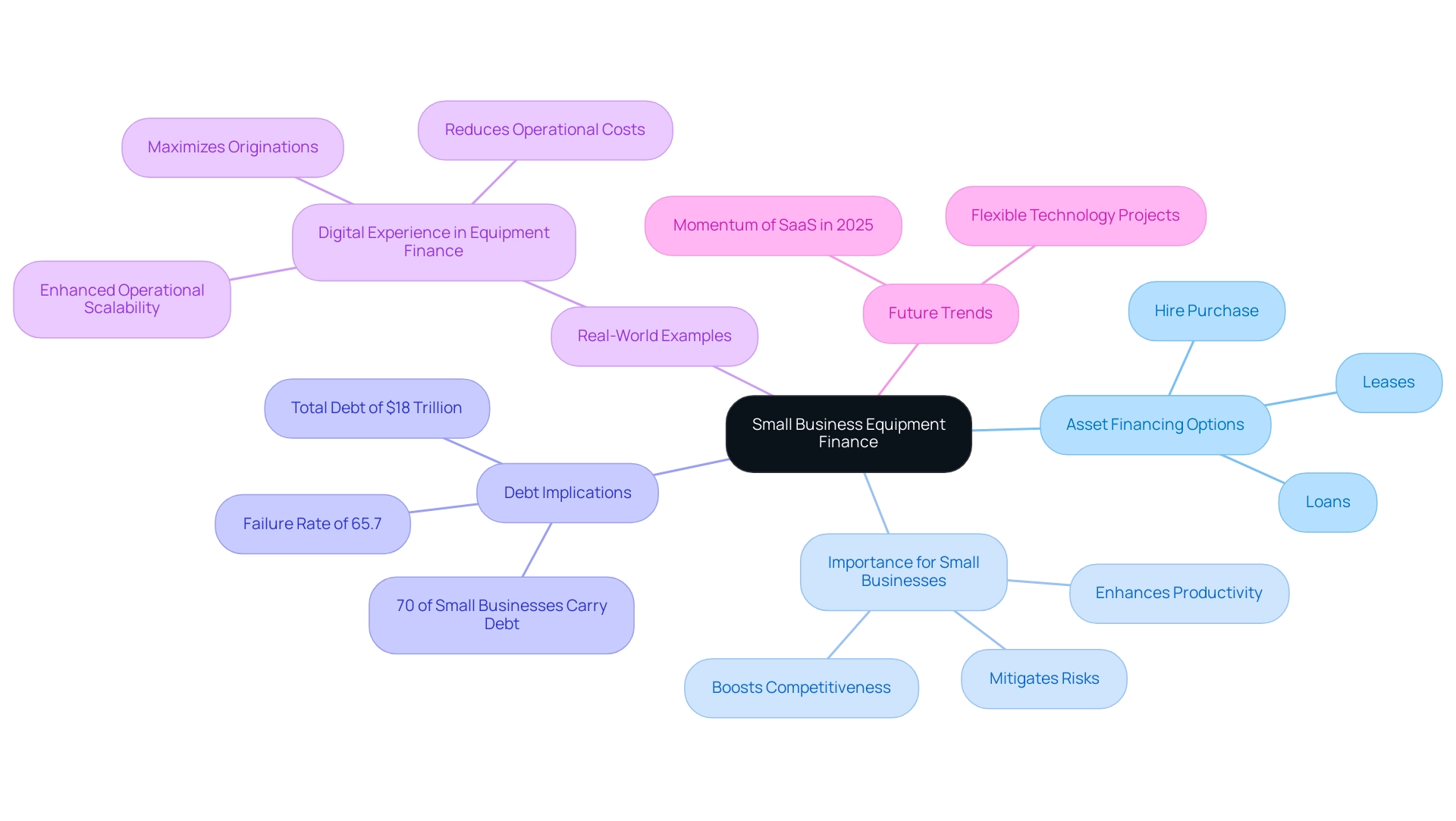
Exploring Different Types of Equipment Financing Options
Minor enterprises have access to a range of small business equipment finance options, each tailored to meet specific operational requirements and financial circumstances. The primary types include:
-
Equipment Loans: These loans empower businesses to purchase equipment outright, with the equipment itself serving as collateral. This option is particularly advantageous for companies aiming to own their assets and build equity over time.
-
Leasing: Leasing allows enterprises to utilize machinery for a predetermined duration while making regular payments. At the end of the lease period, the company does not own the tools, which can be beneficial for those who prefer frequent upgrades without the burden of ownership.
-
Hire Purchase: This financing method resembles leasing but includes an option to purchase the assets at the end of the term. It offers companies the flexibility of ownership while spreading the cost over time.
-
Chattel Mortgages: A chattel mortgage is a loan secured by the equipment itself, enabling enterprises to maintain ownership while making payments. This option can be particularly appealing for organizations looking to leverage their assets for financing.
Each of these options presents unique benefits, making them suitable for various organizational needs, such as small business equipment finance. For example, equipment loans are ideal for enterprises that require long-term ownership, while leasing may better serve those needing flexibility and lower upfront costs.
Recent trends indicate that alternative lenders are increasingly offering flexible terms and lower down payments, particularly for businesses with less-than-perfect credit. This shift is pivotal as it opens funding opportunities for a broader range of entrepreneurs.
In 2025, the financing landscape is evolving, with a notable emphasis on technology and compliance. Companies capable of reporting real-time data and adapting to regulatory changes are poised to gain a competitive edge. As Michael Mousdale, Associate Director, observes, "Companies capable of real-time reporting on a wealth of portfolio data stand to gain significantly, by feeding that data into increasingly sophisticated risk models, and identifying emerging trends early to support changes in strategic direction."
The development of AI tools is expected to accelerate, but lenders must implement key guardrails to ensure operational benefits and compliance with future regulations.
When evaluating loan options, leasing, and hire purchase, companies should consider their cash flow, the significance of ownership, and the potential for tax advantages in relation to small business equipment finance. For instance, machinery loans may offer tax deductions on interest payments, while leasing can provide immediate access to the latest technology without the long-term commitment.
Expert opinions suggest that understanding the nuances of each small business equipment finance choice is crucial for entrepreneurs. By assessing their specific needs and financial situations, entrepreneurs can make informed decisions that align with their growth strategies. As the machinery funding market continues to progress, staying informed about the latest trends and alternatives will enable minor enterprises to secure the best small business equipment finance options available.
Additionally, major companies in the equipment finance services market are developing advanced software to enhance infrastructure management and competitive edge, further illustrating the dynamic nature of this sector.
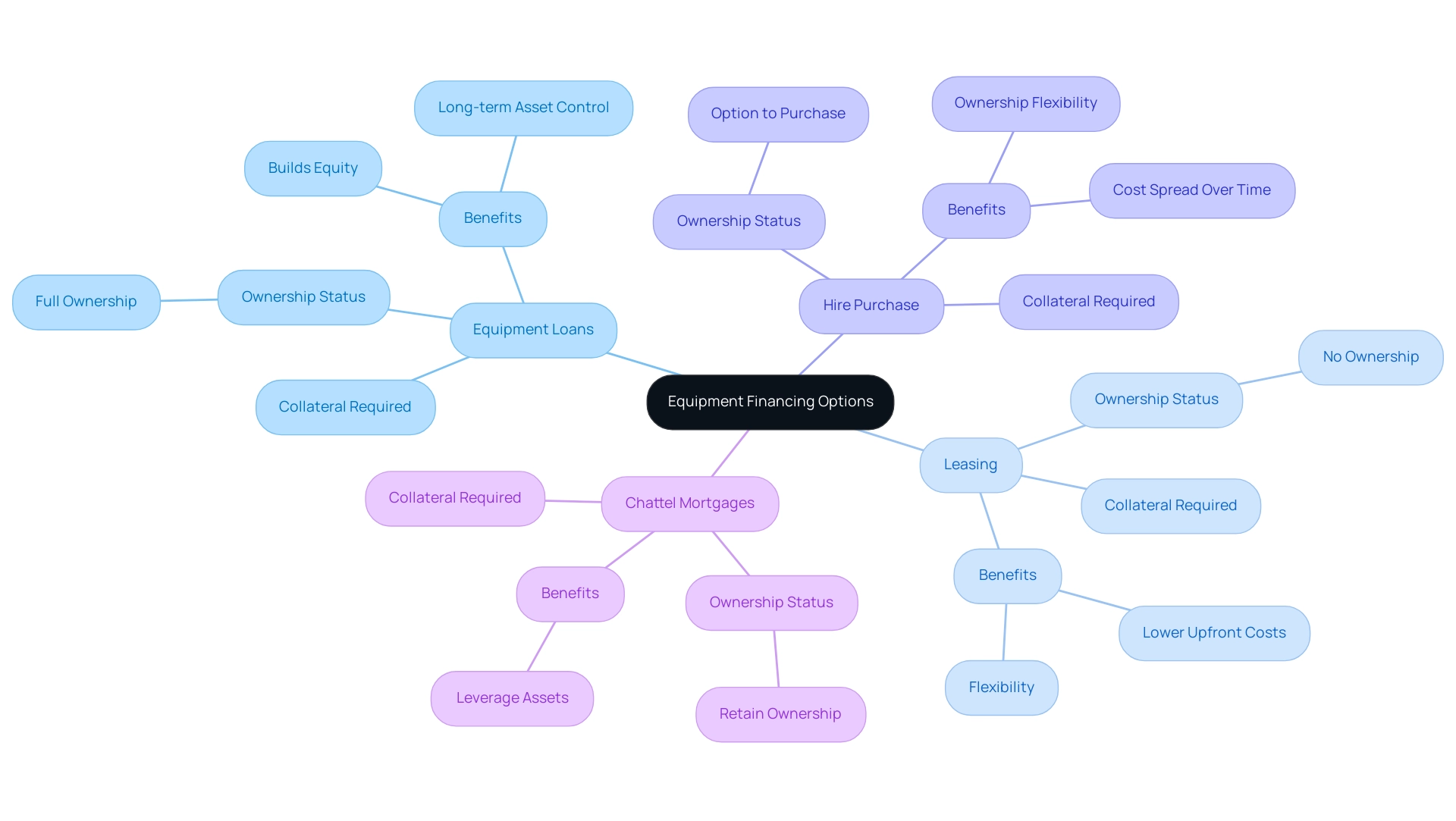
Key Benefits of Equipment Financing for Small Businesses
In 2025, small business equipment finance offers several key advantages for emerging enterprises navigating an evolving economic landscape. These advantages include:
- Improved Cash Flow: By avoiding substantial upfront costs, businesses can preserve liquidity for other operational needs. This is crucial as many small enterprises face cash flow challenges, particularly in the realm of small business equipment finance within a fluctuating market. With the recent cuts by the ECB to 2.5%, effectively managing cash flow has become even more critical for small business equipment finance in these enterprises.
- Access to Latest Technology: Small business equipment finance empowers organizations to acquire cutting-edge equipment that may otherwise be financially out of reach. This access not only enhances operational efficiency but also positions companies leveraging small business equipment finance competitively in their respective markets.
- Tax Advantages: Various funding options provide tax benefits, such as deductions for interest payments. This can significantly lower the total expense of funding, making it a financially sound choice for small enterprise owners.
- Flexible Payment Options: Small business equipment finance allows companies to select payment plans that align with their cash flow cycles. This flexibility is essential for managing small business equipment finance effectively, especially in an environment where interest rates are subject to change.
Data from 2025 indicates that enterprises utilizing small business equipment finance have experienced a notable enhancement in cash flow, with many reporting a 20% increase in liquidity. Practical examples illustrate how businesses have harnessed small business equipment finance to bolster their operational capabilities while ensuring financial stability. For instance, a recent case study titled 'Moving Commodities' highlighted how stable commodity prices have contributed to reduced goods deflation, thereby improving the economic environment and aiding businesses in their funding decisions.
Additionally, a small manufacturing company successfully upgraded its tools through small business equipment finance, achieving a 30% increase in production efficiency and a substantial boost in revenue.
Experts in the field, such as Knutson from Titan Machinery, emphasize that machinery funding not only alleviates short-term financial pressures but also fosters sustained growth. Knutson noted, 'Our revenue forecast for our construction segment is stable compared to the previous year and is supported by asset availability and new product introductions from our suppliers.' As the economy continues to stabilize post-pandemic, the benefits of small business equipment finance are becoming increasingly apparent, establishing it as a vital factor for enterprises striving for success in a competitive landscape.
At Finance Story, we are dedicated to developing refined and highly personalized case studies to present to lenders, ensuring that small enterprise owners can access small business equipment finance solutions tailored to their unique needs. We offer a comprehensive range of lenders, including high street banks and innovative private lending panels, to accommodate any circumstances, whether you are purchasing a warehouse, retail premise, factory, or hospitality venture. With Shane, our Founder and Funding Specialist Director, leading the way, we bring extensive expertise in growth and financing strategies, guiding you through the complexities of securing funds for your commercial investments and refinancing options.
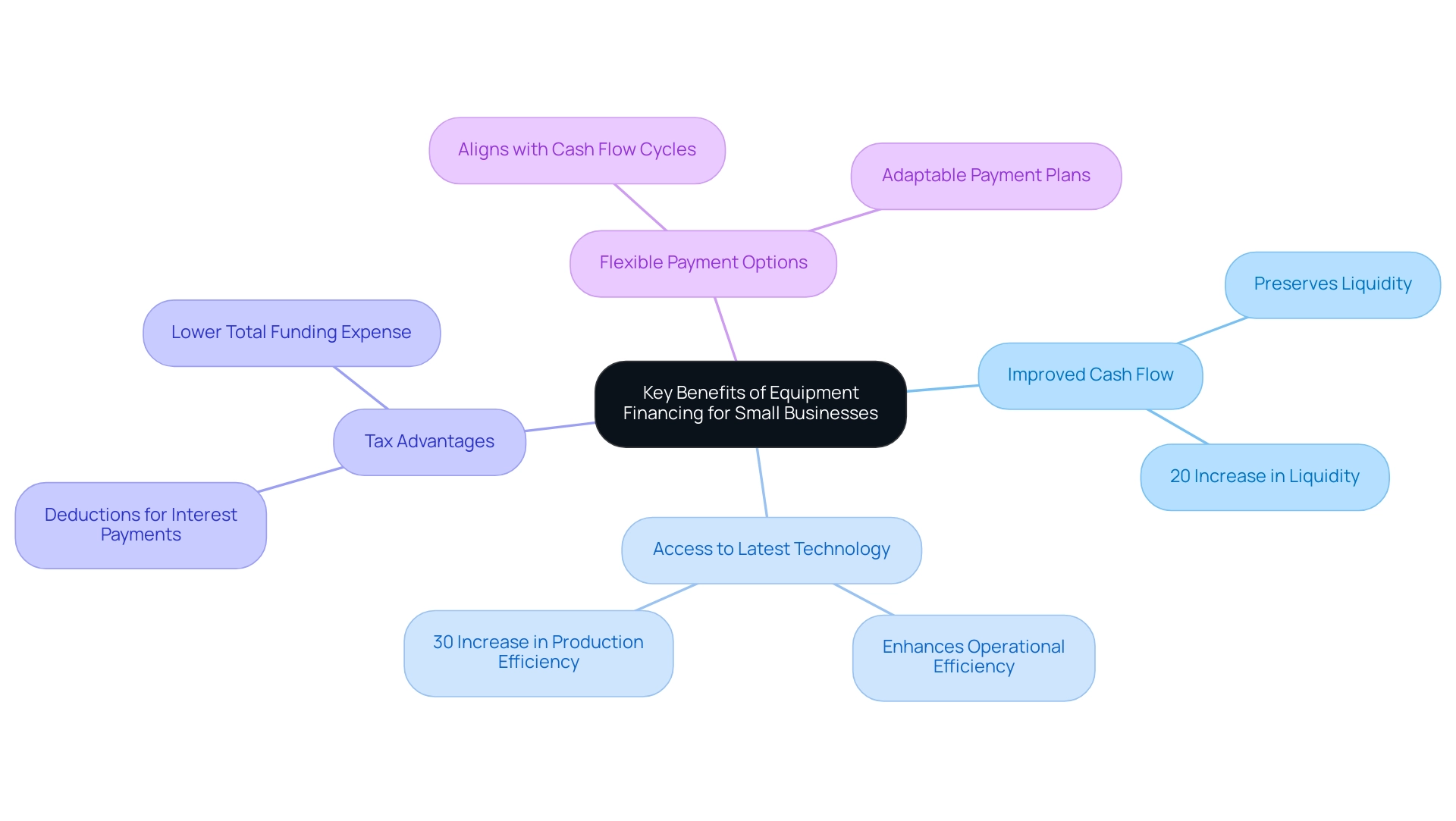
Steps to Secure Equipment Finance: A Practical Guide
Securing finance for tools in 2025 necessitates a strategic approach, encompassing several essential steps:
-
Assess Your Equipment Needs: Begin by identifying the specific equipment necessary for your operations. This assessment should align with your growth objectives and operational requirements.
-
Research Funding Options: Investigate various funding avenues available to you, including loans, leases, and lines of credit. Compare terms from multiple lenders to find the most favorable conditions that suit your financial situation. Finance Story specializes in creating polished and highly individualized cases to present to banks, ensuring you secure the right financing for your needs.
-
Prepare Documentation: Compile all necessary documentation, such as financial statements, a detailed project plan, and your credit history. This preparation is crucial, as lenders will evaluate your financial health and business viability. Understanding the loan repayment criteria is essential, and Finance Story can provide insights on small business equipment finance to help you navigate this process effectively.
-
Submit Applications: Once you have selected your preferred lenders, submit your applications. Ensure that you provide all required information accurately to facilitate a smooth review process.
-
Review Terms: After receiving funding proposals, meticulously review the terms and conditions. Pay close attention to interest rates, repayment schedules, and any fees related to the funding. With access to a full suite of lenders, including high street banks and innovative private lending panels, Finance Story can help you find the best terms for your situation.
-
Finalize the Deal: Upon approval, finalize the financing arrangement. This step involves signing contracts and ensuring that all parties comprehend the responsibilities entailed prior to obtaining the machinery.
In 2025, minor enterprises encounter distinct obstacles in securing small business equipment finance, including variable interest rates and strict lending standards. With over 25 years of experience in enhancing operations and technology implementation, Finance Story is well-equipped to guide entrepreneurs through these complexities. Establishing a solid funding structure is vital for supporting growth initiatives, particularly in the context of small business equipment finance, as emphasized by Jo Morris from Novuna Business Finance.
A thoroughly prepared application can greatly improve your likelihood of acceptance.
Practical advice from specialists indicates that small enterprise owners should also be mindful of typical traps, such as underestimating the overall expense of ownership for tools. Matthew Hinkley emphasizes that with predictive analytics, organizations can enhance their lease asset management, offering a competitive advantage in the funding process. By adhering to these steps and utilizing expert guidance, entrepreneurs can successfully manage the intricacies of small business equipment finance, ensuring they obtain the essential assets to propel their venture ahead.
Finance Story's customized financial solutions have effectively helped clients in obtaining funding, showcasing the brokerage's dedication to comprehending and meeting the distinct requirements of local enterprises.
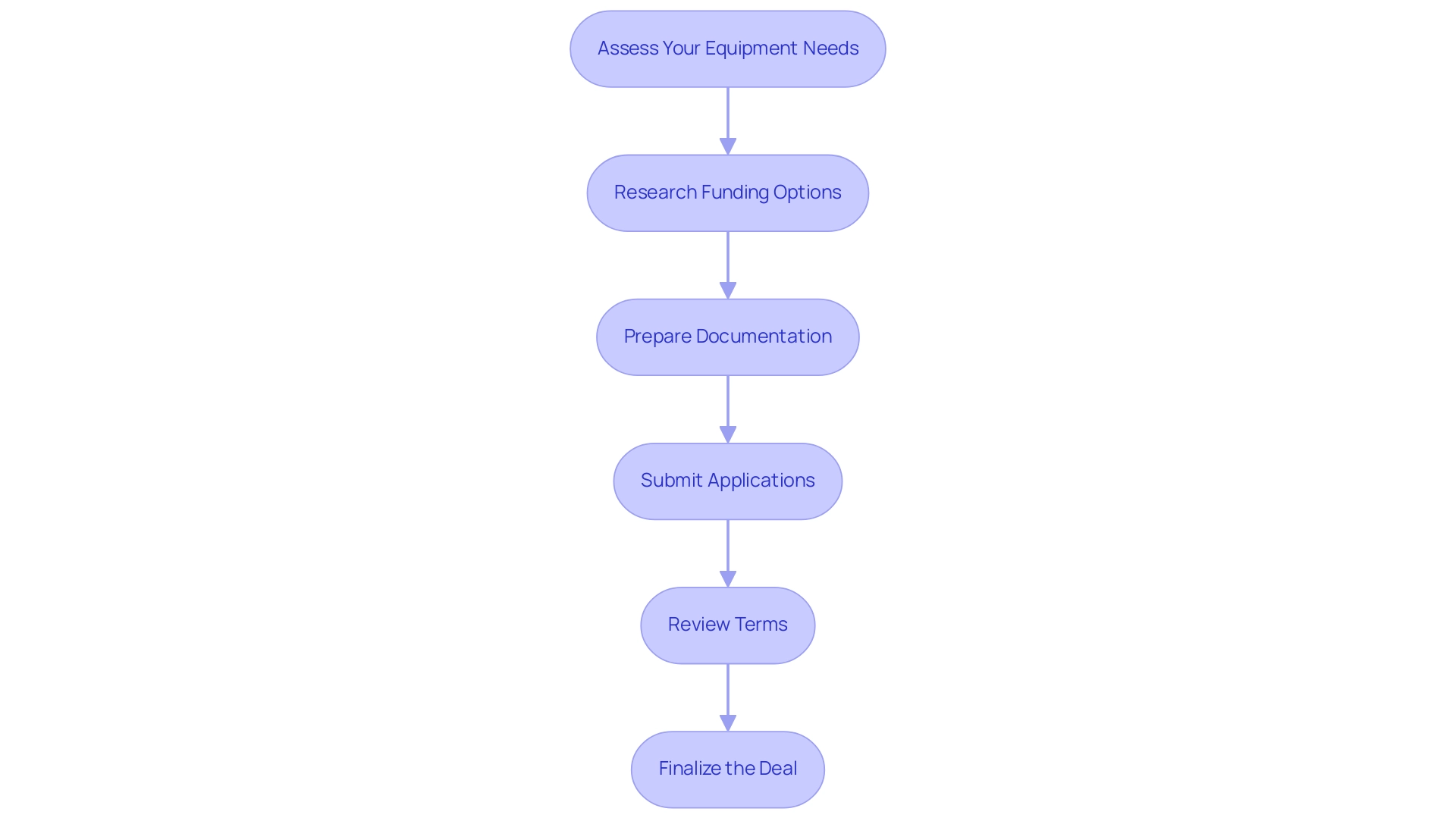
Choosing the Right Equipment Finance Provider: What to Consider
Selecting the right provider for small business equipment finance is crucial for small businesses aiming to optimize their financial strategies. Key factors to consider include:
-
Reputation: Investigate the provider's history and customer feedback. A strong reputation often correlates with reliability and trustworthiness, essential for long-term partnerships.
-
Terms and Conditions: Scrutinize the funding options available, including interest rates, repayment schedules, and any potential hidden fees. Transparent terms can significantly impact your overall financial health.
-
Customer Service: Assess the quality of support provided. A responsive and knowledgeable customer service team can make a substantial difference, especially when navigating complex funding scenarios. As Michael Mousdale noted, well-publicized advancements in AI and other data-based tools can be employed to support increased demand while adhering to established risk policies, highlighting the importance of adaptability in customer service.
-
Flexibility: Seek out providers that offer customizable funding solutions tailored to your specific enterprise needs. Flexibility in terms can help accommodate changes in your operational environment. Finance Story focuses on developing refined and highly tailored proposals for small business equipment finance to present to lenders, ensuring that small enterprises can obtain the appropriate funding for their distinct situations.
-
Industry Experience: Opt for a provider with a proven track record in your industry. Finance Story, with over 25 years of experience in organizational enhancement and technology implementation, exemplifies the significance of industry knowledge in delivering effective funding solutions. Their expertise in refinancing and securing customized loans for commercial property investments positions them as a leader in the field.
-
Diverse Lender Access: Finance Story provides access to a comprehensive portfolio of lenders, including high street banks and innovative private lending panels. This extensive variety of choices guarantees that minor enterprises can discover the appropriate small business equipment finance solution that meets their specific needs.
In 2025, the significance of these elements is highlighted by the increasing tendency of local enterprises utilizing technology to improve their funding processes. For instance, during the June 2024 quarter, mortgage brokers accounted for 73.7% of all new home loans, reflecting a shift towards specialized financial services that cater to unique client needs. This trend emphasizes the importance for minor enterprises to thoroughly assess their small business equipment finance partners, ensuring they select providers that align with their operational objectives and financial strategies.
Furthermore, insights from the veterinary medical apparatus market case study demonstrate how particular industries can gain from customized funding solutions, further increasing the significance for local owners across diverse sectors.
As Natasha B. from VIC stated, 'I will definitely be recommending your service to anyone. We are finished with the constant worry. Once again, thank you so much for being a part of our journey.' This testimonial emphasizes the effectiveness of Finance Story's services in assisting minor enterprises through their funding journeys.
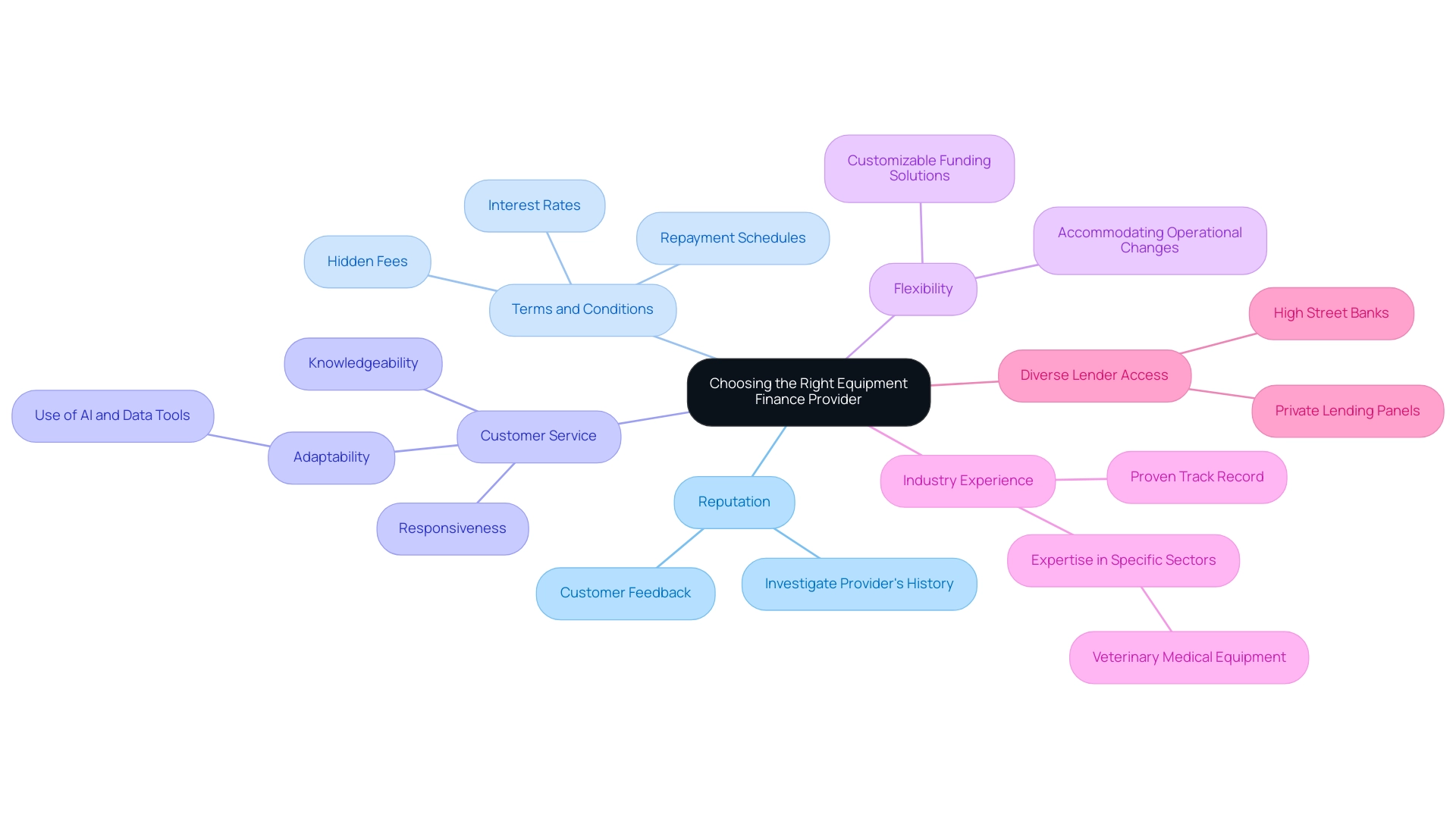
Avoiding Common Mistakes in Equipment Financing
Frequent errors in small business equipment finance can significantly impact a small enterprise's financial health. To navigate this landscape effectively, it’s essential to avoid some critical pitfalls:
- Not Shopping Around: One of the most common mistakes is neglecting to compare multiple lenders. This oversight can result in missed opportunities for more favorable terms and lower interest rates. Research indicates that companies exploring various funding options can reduce their total financing costs by as much as 20%.
When acquiring equipment, businesses must consider the total cost of ownership, especially in the realm of small business equipment finance. This encompasses not just the purchase price but also ongoing expenses such as maintenance, insurance, and potential upgrades. Ignoring these factors can lead to unforeseen financial strain in the future.
-
Overlooking the Fine Print: Many entrepreneurs hastily complete paperwork, overlooking critical terms and conditions. This can result in unexpected fees or unfavorable terms that could have been avoided with a careful review. A recent survey revealed that 30% of small business owners encountered hidden charges in their funding agreements, underscoring the importance of diligence.
-
Rushing the Decision: It is vital to take the necessary time to evaluate funding options. Hasty decisions can lead to regret and financial challenges. Experts recommend that businesses allocate sufficient time to understand the implications of their funding choices, as this can help avert costly mistakes.
To illustrate the importance of understanding unique client needs, Finance Story’s expertise in crafting tailored cases for small business equipment finance demonstrates how a customized approach can help avoid common challenges in equipment funding. By partnering with a diverse range of lenders, including major banks and innovative private lending groups, small enterprises can uncover financing solutions specifically suited to their circumstances.
Furthermore, grasping loan repayment requirements is crucial for effective funding. As Sarah House, managing director and senior economist at Wells Fargo, noted, "We’ve really seen commodity prices move more or less sideways over the past year, so we’re not getting this big downdraft in inflation coming from a correction in those." This insight highlights the current financial landscape that may influence machinery funding decisions.
Moreover, key trends in small business equipment finance for 2025 emphasize the importance of sustainability and data-driven choices, which are increasingly relevant for small enterprises exploring funding options.
By recognizing these frequent errors and proactively addressing them, small businesses can secure more advantageous asset financing and enhance their overall financial stability.
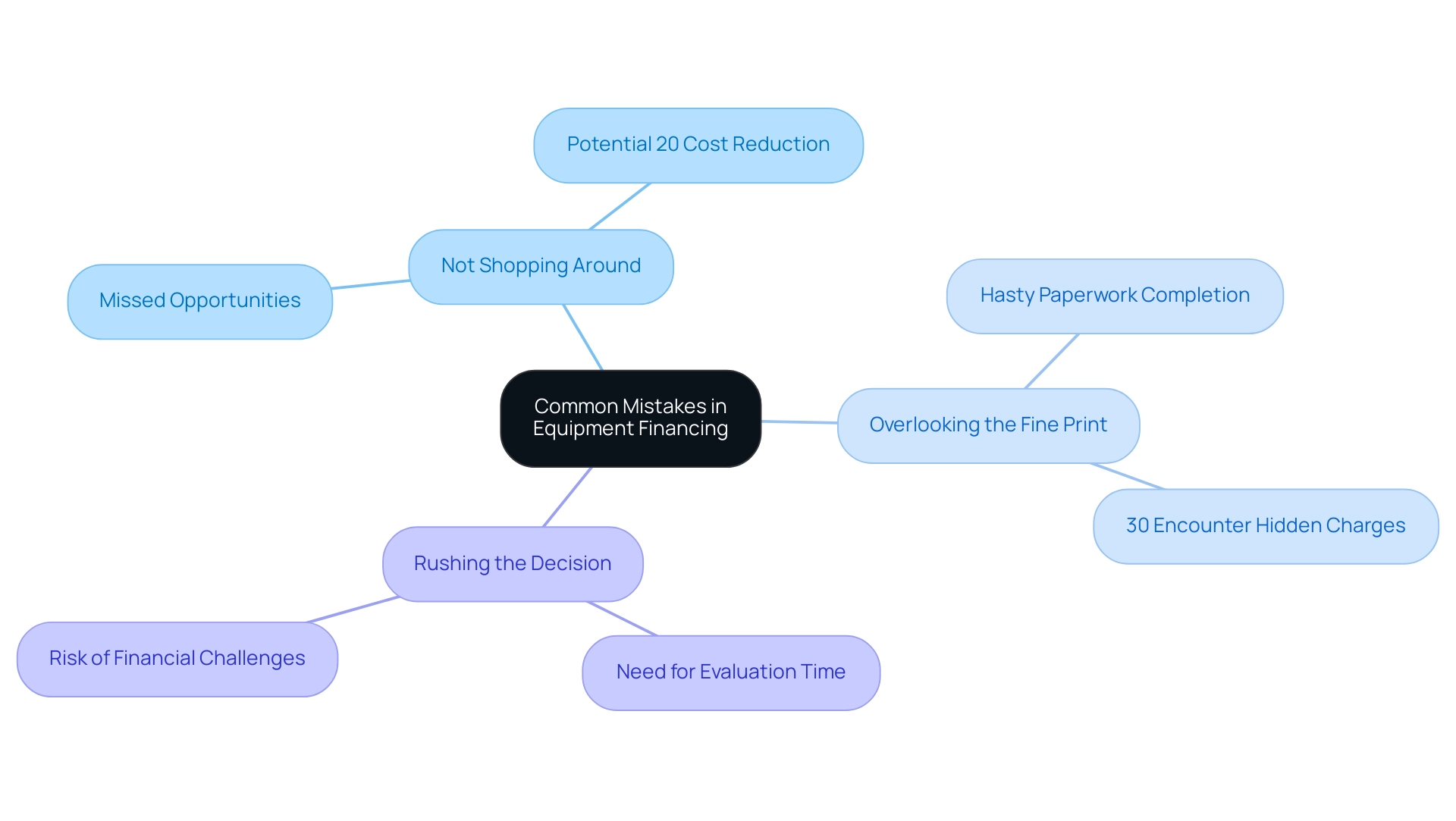
The Future of Equipment Finance: Trends and Innovations
The future of equipment finance is being significantly influenced by several pivotal trends:
-
Technological Advancements: Cutting-edge technologies are revolutionizing the financing process, enabling businesses to access funding more efficiently. Innovations such as AI-driven analytics and automated underwriting are streamlining applications, reducing approval times, and enhancing the overall customer experience. As Michael Mousdale noted, "Well publicized advancements in AI and other data-based tools can be employed to support increased demand, while adhering to established risk policies."
-
Eco-Friendly Funding: As sustainability becomes a priority, funding options that promote environmentally friendly practices are gaining traction. Lenders are increasingly providing eco-friendly funding options for machinery that lowers carbon footprints, aligning with the global push towards sustainability. For example, the case study titled "Innovative Solutions for Emission Reduction" emphasizes how smart technology is being used to enhance energy consumption during peak demand periods, demonstrating the potential for lowering emissions in equipment funding.
-
Increased Flexibility: Acknowledging the varied needs of small enterprises, lenders are adjusting their offerings for small business equipment finance by providing more flexible terms and conditions. This encompasses customizable repayment plans and diverse funding structures, enabling companies to select options that best suit their cash flow and operational needs. Subscription models and pay-per-use arrangements are gaining traction as alternative funding mechanisms in the asset finance market, as evidenced by the popularity of Lynk & Co's subscription model for electric vehicles in the Netherlands.
-
Data-Driven Decisions: The incorporation of data analytics is changing how lenders evaluate risk and make funding decisions. By utilizing big data, lenders can obtain deeper insights into borrower profiles, allowing them to provide more tailored funding solutions in small business equipment finance that address the specific requirements of modest enterprises.
These trends not only reflect the evolving landscape of financing tools but also underscore the importance of innovation in meeting the demands of modern entrepreneurs. As the industry progresses, staying informed about these developments will be crucial for small business owners seeking to optimize their small business equipment finance options. Additionally, the upcoming Equipment Finance Connect event on May 14-15, 2025, will bring together equipment dealers and lenders for discussions and networking, further emphasizing the industry's focus on innovation.
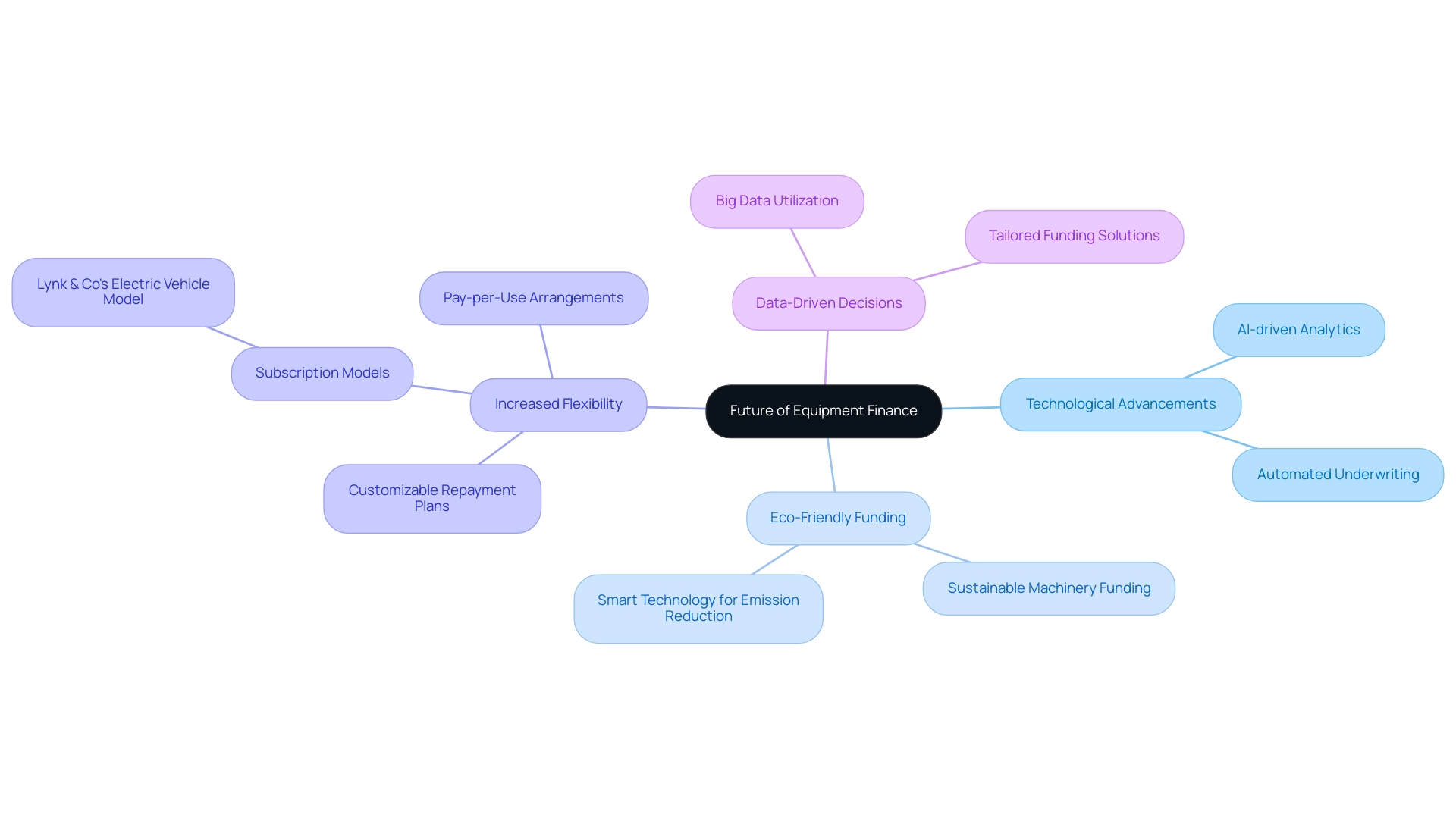
Conclusion
Equipment financing has emerged as a critical component for small businesses aiming to navigate the challenges of a competitive landscape and an evolving market. By understanding various financing options such as loans, leases, and hire purchase agreements, businesses can make informed decisions that align with their operational needs and financial strategies. The strategic use of equipment finance not only preserves cash flow but also enhances productivity, allowing businesses to access the latest technology and maintain a competitive edge.
As the financial landscape shifts towards 2025, small businesses must remain vigilant in selecting the right financing provider. By evaluating factors such as reputation, terms, customer service, and flexibility, entrepreneurs can position themselves to secure advantageous financing solutions. Avoiding common pitfalls, such as neglecting the total cost of ownership and failing to shop around, is essential for optimizing financial health.
Looking ahead, the future of equipment finance is poised for transformation, driven by technological advancements and a growing emphasis on sustainability. With lenders increasingly offering eco-friendly financing options and leveraging data analytics for risk assessment, small businesses must stay informed about these trends to make the most of available opportunities. Embracing these innovations will not only enhance operational efficiency but also support long-term growth in an ever-changing economic landscape. As small businesses continue to adapt and evolve, the right equipment financing strategy will be a vital tool for success.


